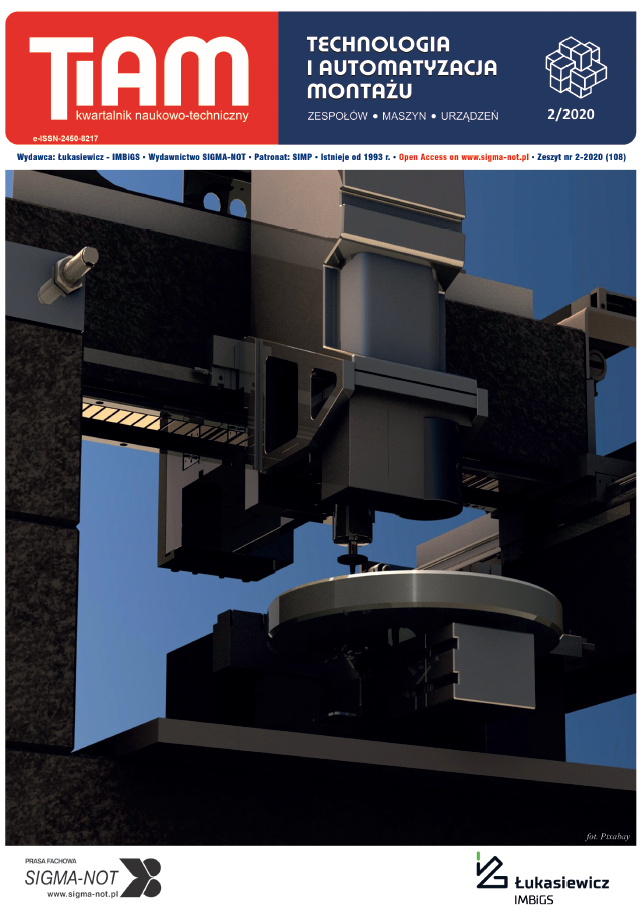Abstract
The purpose of the article was to deepen the state of knowledge regarding the impact of surface roughness on the capacity of single-lap adhesive joints from aluminum alloy 2024. The surfaces with a triangular outline and various height and longitudinal parameters have been deliberately shaped. The surface roughness of the samples was shaped by milling with four different table feed of 30, 50, 70 and 90 [mm/min]. Surface roughness was tested in a 2D system using a contact profilometer. The samples were connected using Loctite EA 3430 epoxy adhesive and then subjected to a static tensile test. As a result of the performed statistical analysis, it was shown that in the adopted variability area, along with the increase of the feed value, the value of roughness parameters and the capacity of joints increased. The highest capacity was obtained for the parameters Ra = 20,83 μm, Rz = 101,33 μm, Rv = 41,97 μm, Rku = 2,62 μm, RSm = 0,746 mm.
This is an Open Access article distributed under the terms of the Creative Commons Attribution License CC BY 4.0 (https://creativecommons.org/licenses/by/4.0/)
References
da Silva L.F.M., das Neves P.J.C., Adams R.D., Wang A., Spelt J.K. 2009. “Analytical models of adhesively bonded joints Part II: Comparative study”. International Journal of Adhesion and Adhesives 29: 331-341.
Dobrzański L. (red.). 2010. Leksykon Materiałoznawstwa. Praktyczne zestawienie norm polskich, zagranicznych i międzynarodowych. Cz. 4, rozdział 1: Metale nieżelazne i ich stopy. Warszawa: Wydawnictwo Verlag Dashofer.
Godzimirski J. 1994. „Czynniki kształtujące wytrzymałość połączeń klejowych”. Technologia i Automatyzacja Montażu 4: 61-64.
Godzimirski J., Kozakiewicz J., Łunarski J., Zielecki W. 1997. Konstrukcyjne połączenia klejowe elementów metalowych w budowie maszyn. Rzeszów: Oficyna Wydawnicza Politechniki Rzeszowskiej.
Kuczmaszewski J. 2006. „Fundamentals of metal-metal adhesive joint design”. Lublin: Politechnika Lubelska, Oddział PAN w Lublinie.
Rudawska A., Danczak I., Müller M., Valasek P. 2016. „The effect of sandblasting on surface properties for adhesion”. International Journal of Adhesion & Adhesives 70: 176– 190.
Rudawska A. 2013. Wybrane zagadnienia konstytuowania połączeń adhezyjnych jednorodnych i hybrydowych. Lublin: Politechnika Lubelska.
Rudawska A. 2014. „Selected aspects of the effect of me¬chanical treatment on surface roughness and adhesive joint strength of steel sheets”. International Journal of Adhesion & Adhesives 50: 235–243.
Sieniawski J. 2009. „Stopy aluminium stosowane w technice lotniczej”. Mechanik 7: 649-654.
Zielecki W. 2007. „Wpływ rozwinięcia struktury powierzchni na wytrzymałość zakładkowych połaczeń klejowych”.Technologia i Automatyzacja Montażu 1,2: 108-111.
Zielecki W., Pawlus P., Perłowski R., Dzierwa A. 2013. “Surface topography effect on strength of lap adhesive joints after mechanical pretreatment”. Archives of Civil and Mechanical Engineering 13: 175-185.
Zielecki W., Pawlus P., Perłowski R., Dzierwa A. 2011. „Analiza wpływu struktury geometrycznej powierzchni w układzie 3D na wytrzymałość połączeń klejowych”. Technologia i Automatyzacja Montażu 1: 33-36.
Ziwei Feng, Hongyun Zhao, Caiwang Tan, Jun Chen, Yong Wang, Bo Chen and Xiaoguo Song. 2019. “Modification of surface treatment on the strength of 30CrMnSiA steel adhesively bonded joints”. Materials Research Express 6: 116521.
https://www.woronko-kleje.pl/sg_obrazki_/00029403_zalac_001.pdf [access: 10.05.2019].


